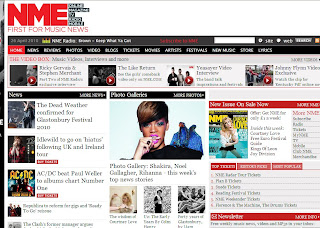As everybody nowadays is keen to switch to advanced technology such as iphone apps and the kindles, the fact that consumers are being offered a chance to read their favourite magazines digitally shows that the production companies of these magazines realise that they need to update the way the consumer can read their magazine in order to keep up with the ever changing market. However, it could cause the sales of hard copies to decrease even further, which would be terrible.
2. Read the TimeWarner press release from July 2001.What did the purchase of British publishers IPC Media bring to the existing portfolio of TimeWarner companies?
As IPC is the UK's leading consumer magazine publisher, when Time Warner bought it, they bought approximately 100 brands including popular magazines such as NME, Loaded and Marie Claire.
3. Find out how many copies of NME (New Musical Express) were sold each week in the 1960s and 1970s (see Wikipedia article on the magazine).
In the 60's NME was selling about 300,000 copies a week. However, in the 70's, it lost ground to The Melody Maker as NME failed to keep up with the ever expanding music market. Nick Logan, former assistant editor was made editor, and sales began to rise again, reaching 600,000 copies a week.
4. What is the current circulation of the magazine?Now read the second TimeWarner article and then visit NME.com.
In 2008, NME relaunched to a less poppy style and aimed at an older more authoratitive audience. Ever since, circulation of the magazine has fallen continuously since 2003. In the second half of 2009, the magazine's circulation was 38,486, 47% down on a 2003 figure of 72,442. However, the editor says that via the different media platforms such as NME radion, the online magazine, the iphone app, the brand NME reaches over a million readers a week.
5. How does the website attract its audience?
As you can see, The NME website is jam packed full of features of famous popular artists, that the reader would want to look at. The line 'First for music news' would make readers think that they will be ahead of others in terms of musical knowledge if they read the magazine and the online article. They have a variety of pictures and features, and they also advertise things such as the actual magazine, t-shirts and concert tickets.

6. Why might people still want to buy a hard copy of the NME magazine?
People sometimes feel that a hard, tangible copy is better as it is a treat, and that readers can indulge themselves, whilst learning about the best music around. Also, the hard copy can always be kept, compared to an online article, which would require you logging on to a website to refind the article. A hard copy can also be read anywhere, on your travels, in the bath, and if you drop it in the bath, its not a big deal, compared to if you dropped your iphone or kindle!





